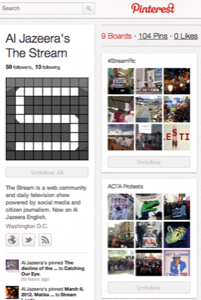Everything was ready to go, but of course Osama bin Laden had to go and ruin it. The night before the debut episode of The Stream on Al Jazeera English, the al Qaeda leader was killed by U.S. Navy SEALS, forcing the producers of the news program to rethink the entire line-up at the last minute.

By the time the show aired, they had managed to schedule an on-air Skype interview with Sohaib Athar, who had unknowingly live-tweeted the beginning of the raid that killed bin Laden. Athar, who Al Jazeera tracked down via Twitter, gave his first on-screen interview on The Stream that Monday. Athar fielded questions not only from the show’s host, but from users across the globe via Twitter.
So how did this scrappy upstart show land such an important source before CNN, BBC and other mainstream broadcast outlets? Chalk it up to being one advantage of the uniquely social media-centric character of The Stream. The program was conceived by Al Jazeera producers as a way to blow the conventional TV news format wide open using the real-time and participatory nature of today’s Web.
“Essentially, The Stream wanted to genuinely and sincerely marry social media and TV and not do it in this very gimmicky way that you see other mainstream media do it,” says Imran Garda, one of the show’s hosts.
From Tweets to Hangouts, a Thoroughly Social Production
To achieve this, they utilize a wide range of platforms, from giant, established incumbents to up-and-coming players in the social networking space.
The role of social media is prominent even in the earliest stages of each episode’s development. The show’s producers crowdsource some of their editorial strategy by opening it up to the Reddit community, who can vote story ideas up or down and chime in with their own thoughts on why a particular topic should be covered.

“If we get a lot of votes for a particular topic, we’ll think of doing an entire show on that,” says Garda. “So there’s a populist element to it.”
More recently, they’ve adopted Pinterest as a way to share photographs and other images related to topics covered on the show. While Twitter and Facebook are naturally very central to the show, the team also routinely makes use of newer tools like Google+ Hangouts for group interviews and Storify for social curation.
“I see them as almost a spiritual partner to us,” says Creative Strategist Ben Connors, referring to Storify. “They were in beta when we were launching and I was for a brief period the most active person on their API site.”
Many of the stories on The Stream are accompanied by a Storify page, which often makes an appearance on the air alongside live video interviews, in-studio guests, YouTube videos and various bits of content from across the Web.
To conduct remote interviews, they use Skype instead of satellite hook-ups, which helps keep costs down. This approach has the added advantage of being ubiquitous and easy to use for those who appear on the show as guests. Rather than relying on some proprietary system for video interviews, The Stream taps into Skype, which has a massive user base. It’s a service that Connors says “is often undervalued as a social network.”
The Drawbacks of Hyper-Social TV Programming
Using a wide variety of Web-based services like this leaves much more room for error than the control rooms and traditional systems, especially considering the show is broadcast live. The team realized this from the outset and has deliberately fostered a somewhat experimental culture in which it’s okay for a video not to load or for somebody to forget to unmute themselves during a Google+ Hangout.
The initial goal when the site launched nine months ago was to launch as innovative of a news program as possible and leave room for fine-tuning later.
Indeed, during live episodes of The Stream, occasionally a YouTube video will fail to load or there might be a momentary issue with somebody’s audio on Skype. When it happens, it doesn’t feel like the kind of thing you tend to observe on a professionally-produced broadcast. Yet something about the multi-dimensional, thoroughly interactive nature of the show lends itself to an implied understanding that, frankly, these things happen. Anybody who’s ever used Skype or Google+ realizes that technical glitches are going to happen.
“If that happened during a news hour on Al Jazeera, someone’s head would roll,” admits Connors. “We’ve managed to create this space where we sort of get away with things like that”
In addition to technical mishaps, the possibility for editorial gaffes is much higher given the nature of The Stream’s format. Although the producers vet their Web-based guests before air time, there’s no absolute safeguard in place preventing somebody’s “jerk of a brother from telling Ban Ki Moon to go screw himself” during a Hangout, as Garda puts it.
Fortunately for the people who put together the show, an incident like that has never happened, but they are certainly aware that the risk exists.
Is This the Future?
Usually when people talk about “social TV” they’re referring primarily to the way that viewers use services like Twitter and Facebook to discuss television shows, which is happening increasingly on “second screen” devices like smartphones and tablets. It’s a major trend. Studies have even shown that shows with louder social buzz tend to have higher ratings than without it.
In the case of The Stream, the “social” aspect of the program is more thoroughly baked in and is prominent throughout the entire production of the show. Garda and Connors both believe that this new breed of “open source” programming isn’t going anywhere, but they also concede that such a format isn’t necessarily always desirable.
There will always be value in a more traditional format, in which the focus is on experts and trained journalists. The crowd is always free to chime in, but it doesn’t always make sense to let their voices be so loud and central to every step of the production process. Still, it’s hard to imagine that this type of bottom-up, super-participatory format won’t have an impact on the way TV shows get made, including beyond the news genre.
“I would be sad if I turned on the TV one day and everything looked like the stream,” says Connors. “I would be equally sad and surprised to turn it on next year and not see a few copycats.”
Lead illustration by Mike Licht.










